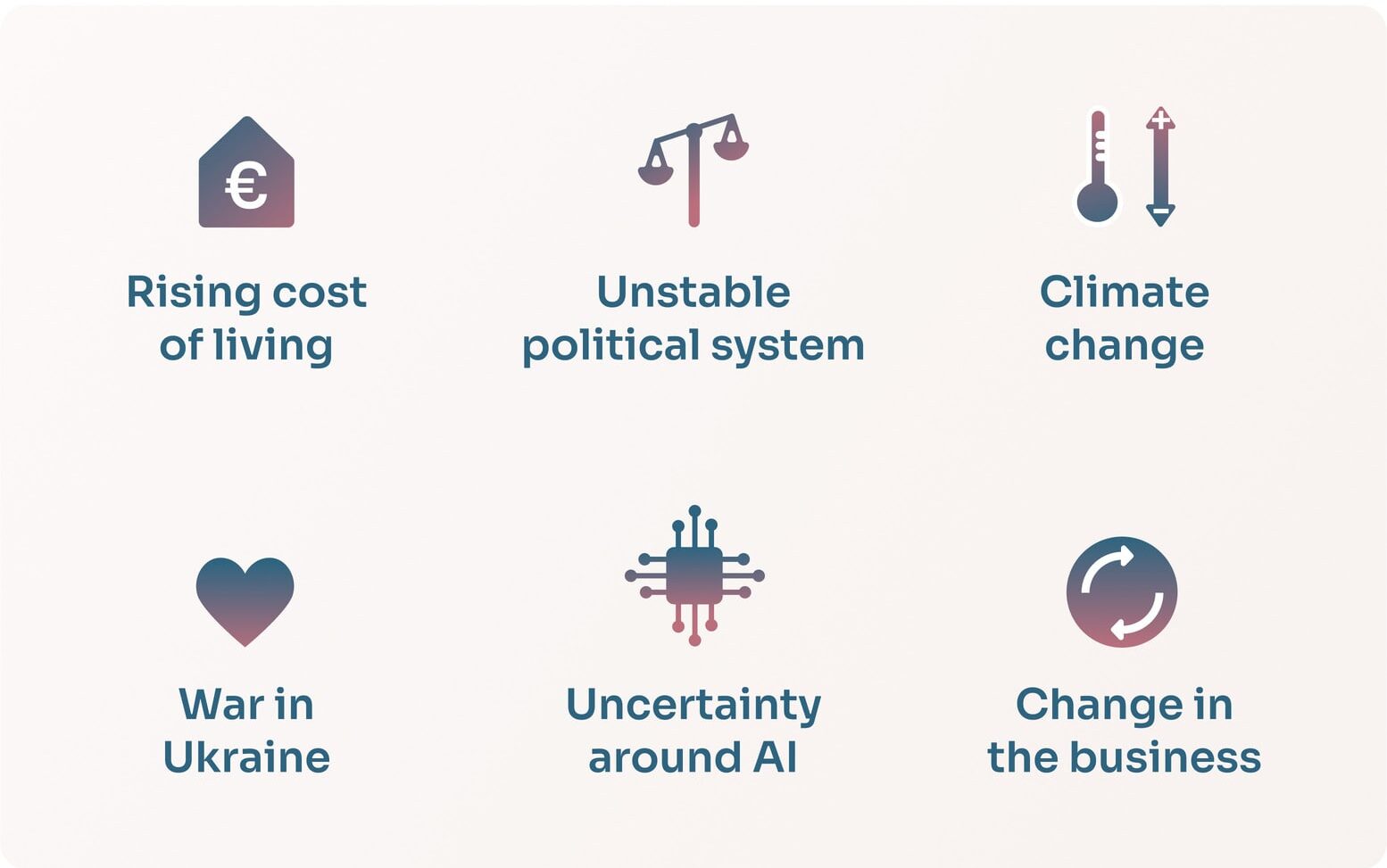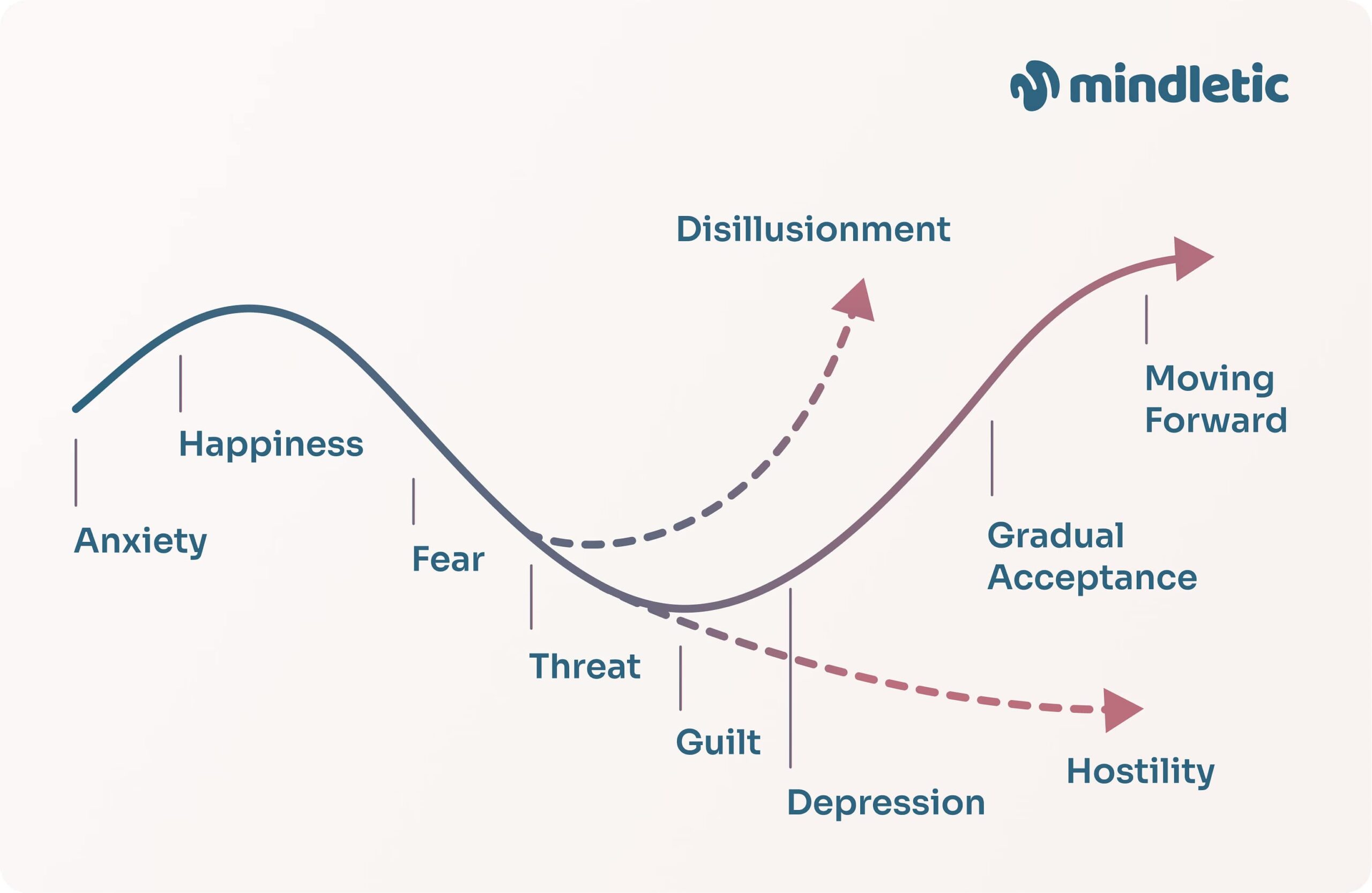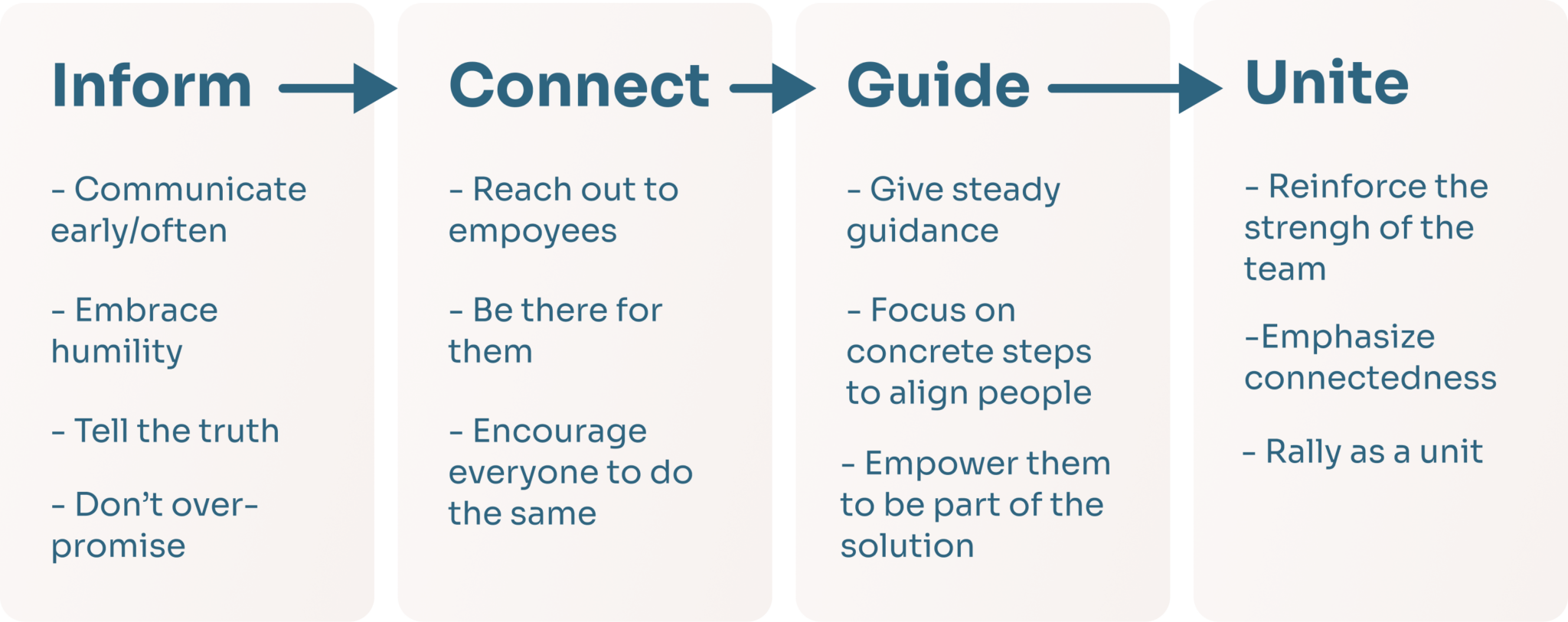Kaip palaikyti komandos gerovę permainų ir netikrumo laikotarpiais

Change is inevitable and necessary for any organization that wants to survive and thrive in a dynamic and competitive environment. However, our brains are hardwired to resist uncertainty, making transitions, such as big mergers, particularly difficult. While we may recognize the long-term benefits of change, the immediate impact on employees can often be overwhelming, sending ripples of doubt across the organization.
Key factors influencing well-being today
Employee well-being is like a puzzle with various pieces. To truly understand employee well-being, we must see the whole picture. The corporate environment is just one piece of this puzzle. Let’s consider the predominant factors impacting our collective well-being:
As we consider these factors, it becomes evident that there’s heightened uncertainty in most teams already. Economic fluctuations, political instability, and looming questions about the impact of AI on job security fuel these anxieties. Beyond these external factors, there may also be changes within the business itself.
Resistance to change
Change is stressful because, to the human mind, uncertainty equals danger. When our brain doesn’t know what’s around the corner, it can’t keep us out of harm’s way.
Neuroimaging studies reveal that the amygdala—a brain region associated with fear responses—becomes active during uncertain events. This means that organizational changes can trigger a neurological reaction, framing these changes as potential threats.
In the context of a corporate shift, even if the current system or method has its limitations, employees are likely to favor it over a new, unfamiliar approach. Consider a new software rollout: employees proficient with the old platform may resist the change, fearing it could impact their job performance.
How change impacts well-being
The change curve, adapted from Dr. Elisabeth Kübler-Ross’s publication, details employees’ emotional responses to changes within the business by outlining various stages and reactions.
At the start of the curve, many employees may feel anxious or shocked, finding it hard to visualize the future. This is largely because, in this phase, employees lack the necessary information to foresee upcoming changes or understand their role within the “new” organization.
How individuals cope with this anxiety determines their progression through the rest of the curve and the impact on their well-being.
Some individuals might feel happiness, realizing that the need for change is both recognized and shared by others, leading to a sense of relief that something will change.
Many people will experience fear or threat. Fear is a natural human reaction to the potential personal effects of change. Some may exhibit denial, behaving as though the change hasn’t occurred; this is a coping strategy often likened to the ‘head in the sand’ syndrome.
Others might feel a sense of disillusionment, questioning the ‘new’ organization’s values, beliefs, and goals. The risk here is that employees may become unmotivated, unfocused, and increasingly dissatisfied. They might start to withdraw, perhaps by ‘quiet quitting’, complaining, or even resigning.
Ideally, individuals will progress to a phase of gradual acceptance. In this stage, they begin to understand the changing environment and their role in it. As confidence builds, the prevailing sentiment becomes: there’s light at the end of the tunnel.
All these feelings are completely normal. According to the change curve model, we should aim to guide everyone through each stage, culminating in the final phase: integration. This phase signifies the moment when individuals begin to regain their sense of control. During this phase, they start to feel more at ease and exhibit increased activity and efficiency.
We must remember that every employee is different. On this journey of change, there may be some pit stops – like anger or a depressed mood. Some people move through the change quickly, others take longer, and some skip certain phases entirely.
So take a moment to think about your team: where are they on this curve? With your team, the aim is to help people through the process as effectively as possible.
Responding to feelings around change & uncertainty
Effective communication with your employees during organizational shifts is crucial; it can influence how they navigate the change curve. There’s a risk that employees may resist change, become hostile, or begin to withdraw. Here are the 4 steps for effective communication during change and uncertainty:
Step 1: Inform
As people struggle to make sense of a new situation, they are hungry for information. Share what you know instead of waiting for perfect news. Honesty is critical. Even if there’s not much to share, communicating that fact is important. When people don’t know what’s coming, their minds are compelled to fill in the blanks, often fearing the worst or making decisions without information.
Step 2: Connect
It is important to generate a feeling of trust with your team. People need to feel a personal and authentic connection with you. Managers who reach out to their people and foster warmth and support, or share their own experiences, are seen as a credible source of reassurance. It’s helpful to admit that you, too, are affected. This signals that you are in touch with your own feelings and gives people opportunities to safely manage their emotions.
Step 3: Guide
During periods of uncertainty, people want confident leaders who are comfortable giving direction. However, it’s too soon to say things like “Put this behind us” or “Get back to business as usual” – such statements can be counterproductive. People may not be ready to discuss long-term visions if they are bracing for more bad news or recovering from previous news. Focus on concrete steps around which the whole team can align.
Step 4: Unite
Challenging times remind us of the importance of community. People need to rally behind the things that bind them together. As a manager, you can pull your people closer by reinforcing what makes them a unique group. Remind the team, “We have adapted before and can do so again – we can still be true to who we are.” Celebrate the team and remind them of their successes. Emphasize their connectedness to each other.
Apibendrinimas
Change can trigger feelings of resistance and uncertainty among your employees, with many feeling threatened, confused, or overwhelmed by the new circumstances. When thinking about those you are particularly concerned about, it may be beneficial to make reasonable adjustments. These are changes to work practices that enable a person to do their job, even when they are struggling, so you don’t lose them.
Jei esate vadovas ir siekiate geriau suprasti, kaip pagerinti savo darbuotojų emocinę sveikatą, kviečiame jus užsiregistruoti pokalbiui su mūsų ekspertų komanda.



